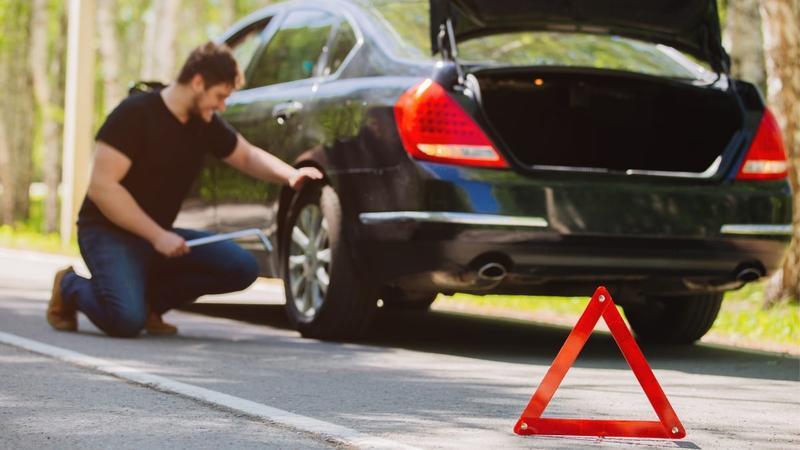Even the newest and best-maintained car can run into trouble on the road. From a flat tire to an overheating engine, there are a number of reasons you might find yourself stranded on the side of the road. Being prepared for such an event is the best way to ensure you – and anyone in your car – stay safe while changing a flat or awaiting help.
Side of the Road Safety
When you find yourself having car trouble, pull over as far off the road and onto the shoulder as you can, and immediately turn on your hazard signals to warn other drivers that there is a problem. Use caution when stepping out of your vehicle; if you can, get out on the shoulder side and not the road side. Keep any children in the car safely inside and belted in so they won’t wander around while you check on the problem.
Especially at night, it is important to set up a warning sign for other vehicles that the car is on the side of the road immobile. Emergency flares or battery-powered warning lights set up several feet apart in the direction of vehicles approaching the site are the best way to do this. This is even more vital if you can’t get the car entirely off the road.
While changing a tire is a good skill to learn, if you aren’t able to do so or aren’t sure what is wrong with the car, stay inside the vehicle and call for assistance. Wait in the car until help arrives. If you need to flag someone down to go for help, do so very cautiously.
The Extra Concerns of Cold Weather
In the winter, a breakdown carries extra safety concerns. Poor visibility will make it harder for other vehicles to see you on the side of the road, and exposure to the cold becomes a potential problem. If your car breaks down in the winter, call for help immediately. Don’t attempt to walk somewhere to get help if you are stuck on the highway in inclement weather; stay with the vehicle and wait for assistance.
Stay inside the car until help arrives. When weather conditions make it difficult to see, being on the side of the road outside the car is even more dangerous, so even if you think you can fix the problem, call for help. The emergency lights on a roadside assistance truck will make it easier for other drivers to spot you and to slow down.
Putting Together an Emergency Kit
Keeping an emergency kit in the car is a smart idea at any time of year, but could truly be life-saving in the winter months. Buy a storage bin and place inside some items that will help keep you safe and warm in a roadside emergency situation. This kit should contain:
- A first aid kit
- Flashlights and extra batteries
- Warm blankets
- Bottled water
- Emergency flares, warning lights and reflective warning signs
- An emergency cell phone battery charger
- Candles and matches
- Fire extinguisher
- Emergency tire sealant to fix punctures
It is also a good idea to keep a small tool kit with basic tools inside as well as jumper cables; and make certain you have a jack and of course a spare tire. Check your spare regularly to make sure it’s in good condition. If you are headed on a long drive and expect to pass through remote areas, add to your kit some non-perishable food, enough to last everyone in the car for a few days. In the winter, add a small folding shovel and a bag of basic clay cat litter, which can help with traction if you get stuck in the snow. Carry chains as well, especially if travelling in mountainous regions. A change of clothes is a good idea as well, in case you get wet dealing with a flat tire or digging out of the snow.
The best way to get safely out of a roadside breakdown or emergency is to make certain you are prepared. Keep your emergency kit in the car at all times, and check the contents regularly to make sure everything is in good working order. Prepare extra items in accordance with your destination; you’ll need a larger emergency kit in the winter and for long drives in areas with spotty cell service.
It is a smart idea to take the time to learn how to change a tire and deal with other minor issues so that if you are stuck in a place where you can’t call for help, you can get yourself back on the road. If you can’t deal with the problem, stay safe in your car until help arrives to get you going again.
